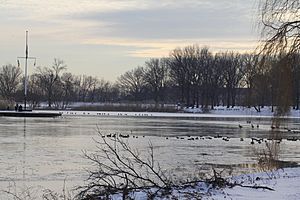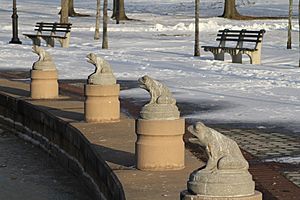Baisley Pond Park facts for kids
Quick facts for kids Baisley Pond Park |
|
|---|---|

View across Baisley Pond
|
|
| Type | Public park |
| Location | Queens, New York City, NY, United States |
| Area | 109.61 acres (44.36 ha) |
| Created | 1919 |
| Operated by | NYC Parks |
| Status | Open all year |
Baisley Pond Park is a fun public park located in the southeastern part of Queens, New York City. It borders the neighborhoods of South Jamaica, Rochdale, and St. Albans. This big park covers about 110 acres (that's like 83 football fields!). Right in the middle of the park is the beautiful Baisley Pond, which is about 30 acres big. The park is looked after by the New York City Department of Parks and Recreation. It's a great spot for people of all ages to enjoy nature and outdoor activities!
Fun Things to Do at Baisley Pond Park
Baisley Pond Park is a super popular place for sports and outdoor fun! You can find lots of cool facilities here. There are areas for barbecues, fields for baseball, basketball courts, and even special paths for riding your bike. If you like cricket, there are fields for that too! You can also find fitness equipment, a football field, and handball courts.
For younger kids, there are five different playgrounds. There's also a running track if you like to jog, and a soccer field. On hot days, you can cool off in the spray showers. And if you need to connect online, several parts of the park have free Wi-Fi.
One special spot is the Sutphin Playground. It has a cool sculpture of an American mastodon. A mastodon was an extinct animal, kind of like an elephant, that lived a long, long time ago. This sculpture reminds us that in the 1850s, workers found the bones of a real mastodon in the pond! This animal lived almost 10,000 years ago, right after the last ice age.
You can also visit the Mother Carter Garden. This pretty garden has a fence around it and places to sit with nice views of the pond. It honors Laura “Mother” Carter, who was a beloved community leader. The park also hosts different events, like the yearly Southern Queens Gospel Festival.
The Pond: Home to Wildlife
The pond is a natural waterway right in the middle of the park. It used to be fed by smaller streams like Beaver Brook and Jamaica Creek. Another stream called Riders Creek also flowed into it from the east. To the south, the pond flows into Cornell Creek, which eventually reaches Jamaica Bay.
The pond is full of interesting plants and animals! You can see lots of lily pads floating on the water. These lily pads are a great hiding spot for American Bullfrogs. The park is also home to three types of turtles: red-eared sliders, snapping turtles, and musk turtles.
If you like fishing, you might find several kinds of fish here. These include largemouth bass, black crappie, bluegill, pumpkinseed, brown bullhead, and common carp.
Many different kinds of water birds love the pond too! In the summer, you might spot great egrets, snowy egrets, great blue herons, and double-crested cormorants. In the winter, even more birds come to visit! You can see species that are less common in the area, like American wigeons, redhead ducks, and grebes. They mix with more common birds like mallards and Canada geese.
History of Baisley Pond Park
Baisley Pond is located in the Jamaica Bay area of western Long Island. It was created way back in the 1700s! Local farmers built dams across three streams to power a mill that ground grain. The pond was named after David Baisley, a farmer who owned the mill in the early 1800s.
In 1852, the growing City of Brooklyn bought the pond from Baisley. They wanted to use it for their new water system. On April 6, 1858, something amazing happened while they were draining the lake to use it as a reservoir. They discovered the remains of an American mastodon at the bottom of the pond! These remains included bones and teeth from the ancient animal.
By that same year, water from Baisley Pond was being sent through a special pipe called the Ridgewood Aqueduct. Then, it was pumped uphill to the Ridgewood Reservoir, where it was distributed to homes in Brooklyn. As Brooklyn grew, this water system was expanded to include more water sources in what are now Queens and Nassau counties.
Eventually, farmers in the area started to complain that their local water table (the underground water level) was getting too low. In 1898, Brooklyn became a part of the City of New York. After this, Baisley Pond was connected to New York's much larger and more reliable upstate water system. This meant the old Brooklyn system, including Baisley Pond, was no longer needed as a main water source.
New York City gave the northern part of the park, including the pond, to the Parks Department in 1914. The park officially opened to the public in 1919. At that time, the area around the park was still mostly countryside. But in the 1920s, many new houses and streets were built, and the area grew quickly.
In the 1930s, during the Great Depression, the Parks Department built even more fun facilities. With help from the Works Progress Administration, they added a boat landing, more playgrounds, tennis courts, and baseball fields. The "Southern Extension" of the park, located south of Rockaway Boulevard, stayed undeveloped for a long time. But in 1984, new sports facilities were finally built there too!



